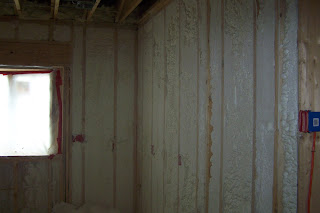Although I haven't posted and we haven't been on site at the project for a bit (a work trip to Tampa for me; a two week stay on the "injured list" for Rob) lots of progress was made in our absence. For each item checked off the main project list by our subs, at least 2 are added to our personal "to-do" list. The completion of the drywall is no exception. The walls and ceilings are now fully taped and mudded throughout to a nice smooth finish. They look great and are ready for the painters to come in and do their stuff. Who are the painters? We have three - me, myself and I. My growing to-do list now includes the requisite two new items - priming interior walls and ceilings and painting interior walls and ceilings and I'm wishing I could clone myself in the near term. The scope of these two items is pretty overwhelming, particularly since I'll be doing all of it on the weekends that I can actually get to VA to work on the project. Lots of driving and painting in my future and, although I'm sure Rob will pitch in when he can, his to-do list is pretty lengthy at the moment, too. And, truth be told, I'm actually a better wall painter than Rob! Enjoy.
Glenlochan -The Beginning

Glenlochan - The Beginning
Glenlochan Today

Glenlochan Today
Tuesday, April 30, 2013
Monday, April 8, 2013
New walls!
The stage of the rebuild process that I've always thought will make Glenlochan seem more like a home again, more than anything else, is the hanging and mudding of drywall. For that reason, I've been anxiously awaiting this stage, so the delivery of the drywall was a big day. It takes a big truck to move heavy and long pieces of drywall:
Multiple sheets of drywall were carefully moved to a second floor window and then brought in through the window and unloaded. This system sure beats carrying each sheet by hand from a truck to the house (which I've actually done on a much smaller scale, and it's not fun at all).
Drywall was then distributed throughout the room of the house so they could be hung as efficiently as possible.
The first ceiling went up very quickly:
A few days later, the drywall was completely hung throughout the house - it looks pretty great!
About eight day's worth of taping and mudding to go and we'll be ready to prime and move to other projects. Some projects are important but have limited visual impact (like rough plumbing) but this is not true of the drywall stage.
Multiple sheets of drywall were carefully moved to a second floor window and then brought in through the window and unloaded. This system sure beats carrying each sheet by hand from a truck to the house (which I've actually done on a much smaller scale, and it's not fun at all).
Drywall was then distributed throughout the room of the house so they could be hung as efficiently as possible.
The first ceiling went up very quickly:
A few days later, the drywall was completely hung throughout the house - it looks pretty great!
About eight day's worth of taping and mudding to go and we'll be ready to prime and move to other projects. Some projects are important but have limited visual impact (like rough plumbing) but this is not true of the drywall stage.
Monday, April 1, 2013
Fun with Foam
If you overhear a conversation about insulation choices these days, you might mistakenly think you were in a biology class. Terms like open cell, closed cell, and cellulose are tossed around and can quickly become confusing. Insulation is an important step in this rebuild, and we wanted to make sure were were installing the best insulating products, balanced against our budget. We elected to use a combination of insulation techniques. largely spray foam, and the process was pretty fascinating.
Insulation day arrived and so did two huge trucks.
First a layer of closed cell spray foam insulation was applied. Closed cell insulation is extremely dense and provides a higher R-value than most other insulation, and is more resistant to leakage of air or water vapor. It is like a hard "outer" shell once applied and dried.
After the closed cell insulation was installed, the open cell foam was sprayed in. Open cell is less dense, but still provides excellent insulating properties, and it is applied in a thicker layer over the closed cell foam.
It looks like a large amount of cake batter, but it also quickly dries hard:
The excess open cell spray insulation is simply sheared even with the framing after it dries:
Insulation day arrived and so did two huge trucks.
First a layer of closed cell spray foam insulation was applied. Closed cell insulation is extremely dense and provides a higher R-value than most other insulation, and is more resistant to leakage of air or water vapor. It is like a hard "outer" shell once applied and dried.
After the closed cell insulation was installed, the open cell foam was sprayed in. Open cell is less dense, but still provides excellent insulating properties, and it is applied in a thicker layer over the closed cell foam.
It looks like a large amount of cake batter, but it also quickly dries hard:
The excess open cell spray insulation is simply sheared even with the framing after it dries:
The end result is smooth, fully insulated, and drywall ready walls:
The ceilings were then insulated with cellulose insulation (recycled cellulosic materials like newspapers and cardboard, with a fire retardant) held in place by netting. Cellulose insulation is natural and provides good insulation, but does tend to settle quite a bit when used in walls.
All that's left, insulation-wise, is the crawl space. We are ready for drywall!
Subscribe to:
Posts (Atom)





























